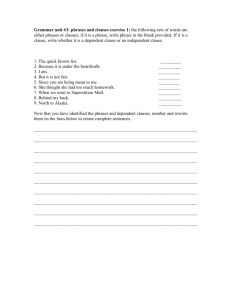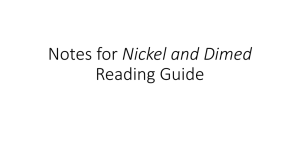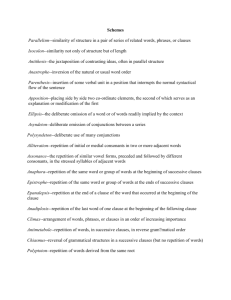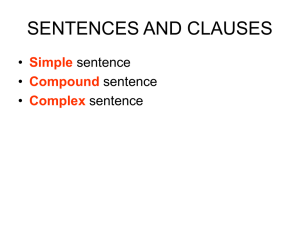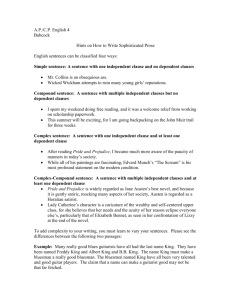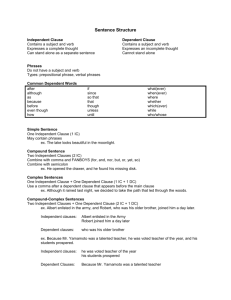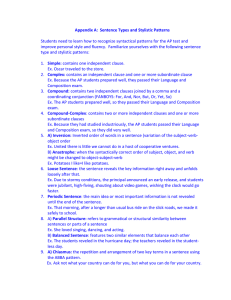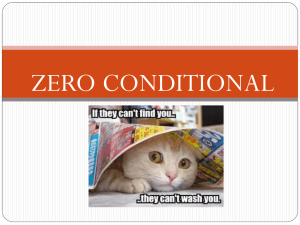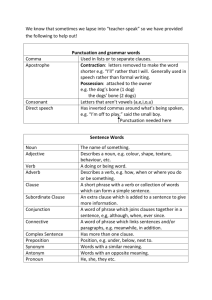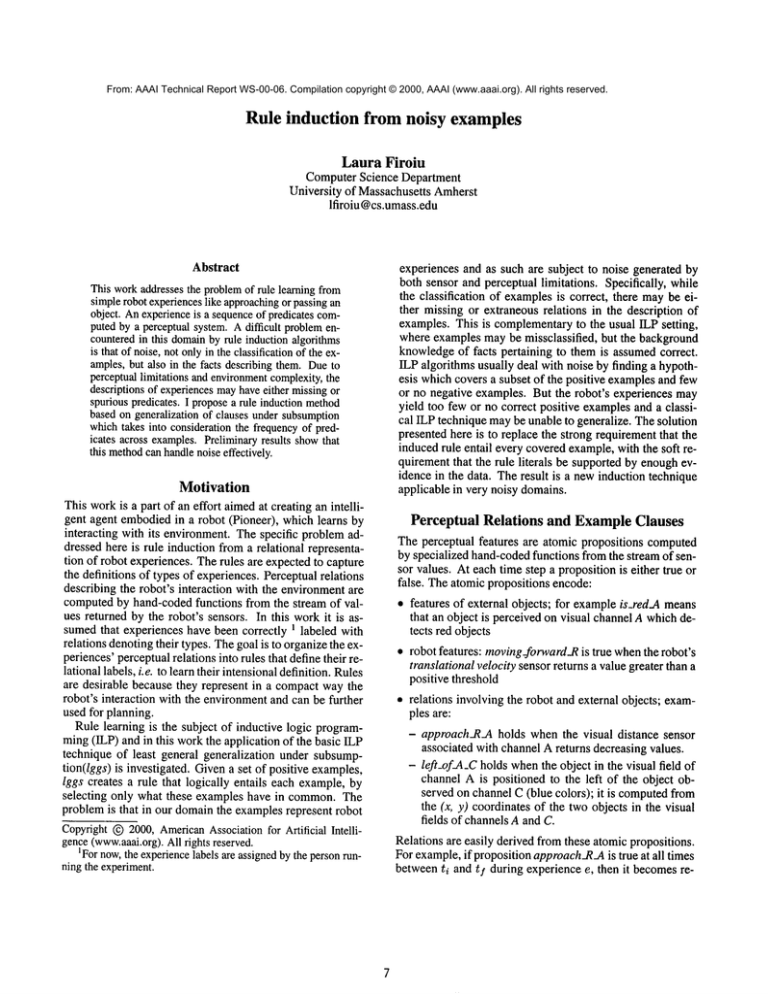
From: AAAI Technical Report WS-00-06. Compilation copyright © 2000, AAAI (www.aaai.org). All rights reserved.
Rule induction from noisy examples
LauraFiroiu
Computer Science Department
University of Massachusetts Amherst
lfiroiu @cs.umass.edu
Abstract
This workaddressesthe problemof rule learning from
simplerobot experienceslike approaching
or passingan
object. Anexperienceis a sequenceof predicates computed by a perceptual system.Adifficult problemencounteredin this domainby rule inductionalgorithms
is that of noise, notonlyin the classificationof the examples,but also in the facts describingthem. Dueto
perceptuallimitations andenvironment
complexity,the
descriptionsof experiencesmayhaveeither missingor
spuriouspredicates. I proposea rule inductionmethod
basedon generalization of clauses undersubsumption
whichtakes into considerationthe frequencyof predicates across examples.Preliminaryresults showthat
this methodcanhandlenoiseeffectively.
Motivation
This workis a part of an effort aimedat creating an intelligent agent embodiedin a robot (Pioneer), which learns
interacting with its environment.The specific problemaddressed here is rule induction from a relational representation of robot experiences. The rules are expected to capture
the definitions of types of experiences. Perceptual relations
describing the robot’s interaction with the environmentare
computedby hand-coded functions from the stream of values returned by the robot’s sensors. In this workit is assumedthat experiences have been correctly 1 labeled with
relations denotingtheir types. Thegoal is to organizethe experiences’ perceptualrelations into rules that define their relational labels, i.e. to learn their intensionaldefinition. Rules
are desirable because they represent in a compactway the
robot’s interaction with the environmentand can be further
used for planning.
Rule learning is the subject of inductive logic programming(ILP) and in this workthe application of the basic ILP
technique of least general generalization under subsumption(Iggs) is investigated. Givena set of positive examples,
Iggs creates a rule that logically entails each example, by
selecting only what these examples have in common.The
problemis that in our domainthe examplesrepresent robot
Copyright@2000, AmericanAssociationfor Artificial Intelligence(www.aaai.org).
All rights reserved.
1Fornow,the experiencelabels are assignedby the personrunningthe experiment.
experiences and as such are subject to noise generated by
both sensor and perceptual limitations. Specifically, while
the classification of examplesis correct, there maybe either missing or extraneous relations in the description of
examples. This is complementaryto the usual ILP setting,
where examplesmaybe missclassified, but the background
knowledgeof facts pertaining to them is assumedcorrect.
ILP algorithms usually deal with noise by finding a hypothesis whichcovers a subset of the positive examplesand few
or no negative examples. But the robot’s experiences may
yield too few or no correct positive examplesand a classical ILP technique maybe unable to generalize. The solution
presented here is to replace the strong requirementthat the
induced rule entail every coveredexample,with the soft requirement that the rule literals be supported by enoughevidence in the data. The result is a newinduction technique
applicable in very noisy domains.
PerceptualRelations and ExampleClauses
The perceptual features are atomic propositions computed
by specialized hand-codedfunctions from the stream of sensor values. At each time step a proposition is either true or
false. The atomic propositions encode:
¯ features of external objects; for exampleis_red_A means
that an object is perceived on visual channel A whichdetects red objects
¯ robot features: moving_forward_R
is true whenthe robot’s
translational velocity sensor returns a value greater than a
positive threshold
¯ relations involving the robot and external objects; examples are:
- approach_R_Aholds when the visual distance sensor
associated with channel A returns decreasing values.
- left_of_A_Cholds whenthe object in the visual field of
channel A is positioned to the left of the object observed on channel C (blue colors); it is computedfrom
the (x, y) coordinates of the two objects in the visual
fields of channelsA and C.
Relations are easily derived from these atomic propositions.
For example,if proposition approach_R_A
is true at all times
betweenti and tf during experience e, then it becomesre-
lation approach(e,ti, tf, r, a). Thereare no function terms
in the resulting first order language.
Figure 1 shows the computedatomic propositions for a
pass_right experience- the robot r movesforward past a red
object a on its right. Theperceptual relations that hold dur-
To Tx
0
3
T2 T3
4 5
I st°p-RJ I
I
T4 ~
14
18
moving_forward_R
move_to_the_le f t_R_A
approach_R_A
I
is_red_A
pass_right_R_n
I
]
Figure 1: The atomic propositions and their temporal extensions for a pass_right experience.
ing an experience are grouped into an exampleclause. The
resulting clause for the experiencein figure 1 is a positive
exampleof a pass_right concept:
stop(eo, To, T1, r), moving_forward(eo, T2, T5,
approach(eo,T3, Ta, a, r),
move_to_the_le
ft( eo, T3, T4, r, a),
is_red(a)
sumptionordering of clauses can be found an ILP booksuch
as (Nienhuys-Cheng& de Wolf 1997).
A clause C subsumesa clause D if there exists a substitution 0 such that C0 C_ D. C -< D denotes "C subsumesD".
If C ___ D then clause C is considered more general than D.
If both C _-_< D and D ___ C then C and D are equivalent
under subsumption,denoted C ,,~ D. It is immediatethat if
C -< D then C ~ D. So if we are looking for a clause that
entails D, we mayfind it amongthe clauses that subsume
D.
Muggleton in (Muggleton 1992) showed that if C ~
D is not a tautology and C is not recursive, then C ~ D.
This meansthat if we do not want to learn recursive concepts, as is the case, then looking for rules in the set of
clauses that subsumethe examplesis an appropriate method,
since the set covers the entire hypothesisspace.
A generalization under subsumptionof a set of clauses
{C1,... Cn} is a clause D that subsumesevery clause Ci in
the set. Finding a generalization under subsumptionof two
clauses C1 and C2 meansfinding two substitutions 01 and
02 and a clause D such that D01 C_ C1 and D02C_ C2. It
1 1.
can be noticed that D C_ C10~
fq C20~
The least general generalization under subsumption
(lggs) of a set of clauses C = {C1,... Cn} is a clause D
that is a generalization of this set and is subsumedby any
other generalization of C.
To < TI < T2 < T3 < Ta < T5
--+ pass_right(eo, To, Ts, r, a).
In the exampleclauses the time constants 2 are replaced by
time variables, because we do not want event occurrence at
the sametime steps during different experiences to be considered meaningfulfor induction. As a result, a learned rule
will not state that the robot muststart movingat the 5th time
step, but at someunspecified time Tk.
-~p(Z,
Y)
01
=
2Asin PROLOG,
the variablesare capitalized andthe constants
are writtenin lowercase.
Y/b}
//
p(a, b) --> q(b,c):,’ p(X, b), rld) -->
ILl’, Subsumptionand Merging
The general problem inductive logic programmingtries to
solve is that of finding a hypothesisthat together with background knowledgeexplains a set of positive examples and
does not contradict a set of negative examples. Usually the
backgroundknowledge, the examplesand the hypothesis are
sets of first order clauses.
In this workwe deal with a restricted setting of the induction problem: the language is function free, neither background knowledge,nor negative examplesare given and the
concepts to be learned are assumed non-recursive. Also,
the positive examplesare definite clauses, meaningthat no
constraints are imposedon the learned rules. In this simplified setting, the hypothesis can be found amongthe clauses
that subsumethe set of positive examples. Specifically,
the hypothesis is taken to be the least general generalization under subsumption(lggs) of the set of examples. Subsumption and lggs are basic ILP concepts due to Plotkin
and will be presented only informally here. Formal definitions and properties regarding subsumptionand the sub-
{Z/a,~/’~{Z/x,
{Y/b}
i
p(Z,b)"-->q(b,
01
=
{Z/a,~/
p(a,b) -->q(b,c)
~{Z/x,
Y/d}
p(X,b),r(d)-->q(b,d)
Figure 2: -~p(Z, Y) is a generalization under subsumption
of clauses p(a, b) ~ q(b, andp(X,b), r (d) --+ q(b,
p( Z, b) --+ q(b, is theIggsof the t wo clauses.
Both generalization and least general generalization under
subsumptionare illustrated in figure 2. Becausethe Iggs of a
set of exampleclauses is the least general clause that entails
all the examples,it makesa goodhypothesis.
In order to understand whythe lggs of a set of clauses
does not alwaysyield an adequate rule in our domain,let us
look at three "push" experiences:
stop(e27, To, T1, r), moving_forward(e27,T2, Ts,
approach(e27,T3, T4, r, c), contact (e27, Ts, Ts, r),
is_blue(c)
-+ push(e27, To, T5, r, c)
stop( e2s , To, T1, r), moving_forward(e2s , T2, T6, r),
approach(e28,T3, T4, r, c), contact (e27, Ws,T6,
is_blue(c)
--+ push(e2s, To, T6, r, c)
To, T1, r),
moving_forward(e29,T2, T5, r),
approach(e29,T3, T4, r, c),
is_blue(c)
-4 push(e29, To, T5, r, c)
8top(e29,
The lggs of the three clauses is:
stop(E, To, T1, r ) , moving_forward(E,
T2 , T5, r
approach(E,7"3, T4, r, c),
is_blue(c)
-4 push(E, To, To, r, c)
It can be noticed that the literal contact(.) does not occur
in the third exampleand therefore it does not occur in the
induced 3 rule. But we knowthat contact is a defining predicate for a "push" experience. Its absence from the third
clause is due to sensor limitations not recoveredby the perceptual system. If negative examplesor constraints wouldbe
present, a classical ILP methodmight discard the third exampleas noisy and create a rule based only on the first two
examples.The problemis that in this domainthe noise level
is high and there maybe only a few or no correct examples.
The solution adopted here is to create a mergedclause
that keeps all literals present in the examples,but remembers
for each literal the numberof times it was encounteredin
examples. The algorithm that creates this clause is called
the mergingalgorithm and is described in the next section.
The mergedclause of the three examplesabove is:
stop(E, To, 7"1, r), moving_forward(E,T2,7"6, r),
approach(E,T3, T4, r, c),
contact(E, To, T6, r), contact(E, T6, T6, r),
is_blue(c)
-+ push(E,To, 7"6, r, c)
A mergedclause for a kind of experiencesis not the defining
rule for that kind, but an accumulationof evidence. After
a numberof examples, the rule can be extracted from the
mergedclause by selecting only the literals whosestrength
is abovea certain threshold denoted by concept_threshold.
For example, notice that in the above mergedclause there
are two contact literals, with distinct time structures. Future
exampleswill decide whichone will appear in the rule.
3Nosubstitution canmakea
includedin the third clause.
rule withcontact(.) in its bodybe
The merging algorithm
The algorithm is incremental. For each concept it finds a
generalization under subsumptionof two clauses: the new
exampleand the mergedclause of the previous examples.
Algorithm 1 merging({E})
input: a set of exampleclauses {E}for a concept
output: the mergedclause for the concept
* M+--0
¯ for each exampleclause E:
1. size(p) +- 1, strength(l) +-- 1 for each literal I E E
size(E) ~-- #literals I E E + #terms t E E
then M ~ E
2. if M = 0 else
M +-- match_clauses(M, E)
Algorithmmatch_clauses, invoked at step 2 of algorithm
merging, finds a generalization under subsumption of two
clauses, Mand E such that the size of the resulting merged
clause is minimizedheuristically - the size of a clause is
the sumof the sizes of its distinct literals and terms. For
the mergedclause the size of a literal is initialized with its
strength, so algorithm match_clauseswill first match M’s
strongest literals. The algorithm does not backtrack, so the
search for a generalization is mostlyinfluenced by these literals.
Algorithm 2 match_clauses(M, E)
input: a mergedclause Mand a clause E
~
output: a mergedclause M
1. size(l) +-- strength(1) for each literal ! E M, M’ +- 0
2. while there exists a pair of compatibleliterals (1,p), l
M, pEE
(a) find the pair of compatible 4 literals (1,p) whose
matchingwith substitutions a and fl yields the clause
-1 U E/~-1 with the smallest size
Ma
(b) M +-- Ma-1, -1
E +-- E~
(c) for every I E Midentical with a p E
¯ M+--M-{I},E+--E-{p}
¯ strength(l) +-- strength(l) + strength(p)
¯ M’+--M’U{I}
(d) markthe newterms in a and/~ as non-replaceable during future literal matchings
3. M’ ~ M’UMUE
Algorithm 2 computesa generalization of clauses Mand
E subject to two restrictions: (1) each term in Mor E
replaced (i.e. matchedwith another term) at most once and
(2) each literal in Mor E is matched at most once. Due
to the first restriction the non-matched
literals in the example clause are added to the mergedclause with their terms
properly replaced. The second restriction avoids the eventual matchof a literal representing an event in the experience clause with distinct events of the sametype - literals
with the same predicate symbol- in the mergedclause. It
can be noticed that if we consider a graph representation of
4Two literals I andp are compatible
if theyhavethe samepredicate symbol
andsign andthere exist twosubstitutionsc~and/3that
match/withp:lc~-1 = p/3-1.
clauses, whereeach distinct literal and each distinct term is
a vertex, then algorithm match_clausesimplementsa heuristic search for the largest isomorphicsubgraphsof the graphs
associated with Mand E.
stop (E, to, tl, r), moving_forward
(E, t2, t3, r),
approach(E,t3, t4, r, V)
-~ approach_exp(E, to, t4, r, V)
stop(E, to, tl, r), moving_forward(E,
t2, t6, r),
approach(E,t3, t4, r, V),
contact( E, tb , t6, r)
--+ push(E,to, t6, r, V)
Preliminaryresults
Experiment 1
Our data set has forty two experiencesgroupedin nine types.
The experiences are very simple and involve either one object - approaching, passing, or pushing the object, or two
objects - passing both objects or first passing one object and
then pushing the other one. Thesetypes of experiences represent the concepts whosedefinitions must be learned. Because very few examplesare present for each concept, the
threshold for including literals was set very low, at 55 percent of the maximum
strength of the literals in the merged
clause.
The learned definitions of the 9 concepts are shownin
table 1. Timerelations were removedfor clarity, but the
indices of the time variables observethe temporalorder.
It can be noticed that in general, the rules capture the meaningful events for each experience type,
with the exception of "pass_right", "pass_left" and
"pass_left_then_pass_right" which have the samerule. This
might eventually be avoided by lowering the threshold for
extracting rules fromtheir mergedclauses until distinguishing literals are promotedin the rule.
For comparison, table 2 lists someof the rules learned
by CProgol4.4 (Muggleton 1995) from the same data set,
with the constraint that rules for different concepts must
be distinct. BecauseProgol tries to find short hypotheses,
the rules it induces have few literals, and important features may be ignored in some cases. For example, it can
be noticed in table 2 that contact is missingfromthe rule for
pass_left_then_push.
stop (E, to, tl, r), moving_forward
(E, t2, ts, r)
--+ pass_right(E,to, ta, r, V)
stop(E, to, tl, r), moving_forward(E,
t2, t3, r)
pass_left(E, to, t3, r, V)
stop(E, to, tl, r), moving_forward(E,
t2 , t6 , r )
move_to_the_right(E,t3, t4, r, a),
is_red(a), is_blue(c),
contact(E, tb, t6, r)
--+ pass_left_then_push(E,to, t6, r, a, c)
stop(E, to, t2, r), moving_forward(E,
t4, tg, r),
approach(E,tb, tT, r, a),
move_to_the_left(E,t6, tT, r, a),
right_of(E, tl, t3, a, c), front_of(E, tl, t3, a,
is_red(a),
is_blue(c),
contact(E, ts, tg, r)
-~ pass_right_then_push(E,to, tg, r, a, c)
stop(E, to, tl, r), moving_forward(E,
t2, t6, r),
approach(E,t4, tb, r, a),
move_to_the_right
(E, t3, tb, r, a),
is_red(a), is_blue(c),
left_of(E, tb, tb, a, c), front_of(E, tb, t~, a,
--~ pass_left_then_pass_left(E,to, t6, r, a, c)
stop(E, to, tl, r), moving_forward(E,
t2, t3, r)
-+ pass_left_then_pass_right(E,to, t3, r, Vo, Vx)
stop(E, to, h, r), moving_forward(E,
t2, t8, r),
approach(E,t3, tb, r, c),
move_to_the_left(E,t4, tb, r, c),
approach(E,t3, t6, r, a),
move_to_the_left(E,
tb , t T , r, a),
is_red(a), is_blue(c),
behind(E,to, tb, a, c), left_of(E, tb, tb, a, c)
---r pass_right_then_pass_right(
E, to, ts, r, c, a)
Experiment 2
The problemof applying ILP to learning relational concepts
from robot sensor data has been previously studied by Klinspor et. al. in (Klingspor, Morik, &Rieger 1996). GRDT,
their ILP system uses grammarsto describe the hypothesis space and looks for rules with high coverage of positive examplesand low coverage of negative examples. Table
3 showsthe results obtained by applying the mergingalgorithm to one of their data sets, "basic feature set 2", available
on mlnet.org. The learned concept "s_jump"is at the bottom
of their concepthierarchy, and as such it is defined in terms
of perceptual features. I assumethat their features are also
noisy, since they are computeddirectly from sensor values.
Theseperceptual features are similar with our perceptual relations in that they also have time extents. I created an exampleclause for each concept instance in the training data
set by considering all the perceptual features whosetime extents overlap with the extent of the concept instance. As in
the experimentsreported in their paper, the inducedrules are
evaluatedon a test data set twice as large as the training set.
Becauseconcepts in their data set cannot be defined by
single rules, the mergingalgorithm was modifiedas follows:
Table 1: Rules learned by mergingfor the nine types of experiencesin the data set.
¯ a new example E maybe mergedwith a previous clause
Monly if their literals are well matched:
= strength(Ma-1 fq E/~-I) > merging_threshold
strength( Ma-1 -1
U )E~
where a-a and ~-1 are the same as in algorithm 2; for
the result in table 3 the merging_threshold
wasset to .55
fit
¯ example E is merged with the clause Mfor which the
bestfit is obtained
10
approach(A,E, C, r, D) --~ approach_exp(
A, B, C, r, D
push(e29,O, 19, r, c).
contact(A,E, C, r) --~ push(A,B, C, r, D
moving_forward(A,
E, C, r) --~ pass_right(A, B, C, r,
move_to_the_right(A,
E, F, r, D) --~ pass_left(A, B, C, r, D
move_to_the_right(A,
F, G, r, D ), is_red(D)
-+ pass_left_then_push(A,B, C, r, D, E).
left_of(A, F, G, D, E)
--+ pass-left_then_pass_le
f t( A, B, C, r, D,E).
Table 2: Rules learned by CProgol4.4 for six of the nine
types of experiencesin the data set.
Discussion
¯ because strength(M) increases through merging and
maypreclude future merges, the weakest literals of M
are dropped, provided their total strength is below a
drop_threshold(.05 in the experiment)
The threshold values were chosen as follows:
¯ the merging_thresholdis low, to allow initial mergesto
take place
¯ the drop_thresholdis low, so that only the least frequent
occurring literals are dropped; experiments showedthat
for values greater than .15, the mergedclauses become
too general
¯ the concept_thresholdwhichselects the literals retained
in the final rule was.55; becausethey already lost literals during merging, the resulting mergedclauses are not
very specialized, so a higher value of this threshold would
makethem too general
GRDT
GRENDEL
Merging
#rules
12.8
3.5
43
specialized rules. Because the derived test exampleswere
obtained through crisp logical inference by PROLOG,
the
rules fail to recognize the exampleswith missing literals.
Experimentswith various threshold values showedthat either precision can be increased at the expenseof recall, or
recall be increased at the expenseof precision. Becausethey
affect the entire induction process, these parametersare very
important, so a better methodfor selecting and eventually
adapting their values must be found.
recall precision
28.1%
53.4%
10.1%
21.6%
14.5%
57.9%
Table 3: Results reported in (Klingspor, Morik, & Rieger
1996) and obtained by merging for the "basic feature set
precision - correct
2" data set: recall = correct
given ’
derived ’
where correct is the number of correctly derived examples, derived is the total numberof derived examplesand
given is the actual number of positive examples. GRENDELis another grammar-basedILP system, taken as baseline. The derived examples were obtained by a PROLOG
interpreter fromthe test data and the inducedrules. Theresults
for GRDTand GRENDEL
are averaged over four concepts:
"s_jump"and three others at the samelevel in the hierarchy.
The results for mergingare only for "s_jump".
The results in table 3 indicate howthe mergingalgorithm
performs: it has lower recall and slightly higher precision
than their system (though it performs better than the baseline), and induces a muchlarger numberof rules. This is
expected, since by retaining literals which mayappear in
the assumedcovered exampleclauses, merging creates more
11
In order to deal with noise in the factual description of examples, the methodinvestigated in this workgives up the requirement that the hypothesis be consistent with every covered example.The resulting rule maycontain literals that do
not occur in a particular example,but their presenceis supported by other examples.Preliminary results showthat in a
very noisy domain, where a methodfollowing crisp logic
maylead to rules based on irrelevant predicates, this approach leads to rules that intuitively makesense to a human
observer. This technique can be extendedto deal with missclassified or unclassified examples: a new examplecan be
assigned to one of the previous clusters based on howwell
it fits the mergedclauseof that cluster.
Alternative approachesfor induction either fromnoiseless
positive data (Muggleton1996), or from noisy positive and
negative examples, (McCreath & Sharma 1997) maximize
an estimate of P(HIE), the probability of the hypothesis
given the data. Whilethese methodsare moreprincipled because error boundsare guaranteed for the induced hypotheses, they do not deal explicitly with the case of erroneous
backgroundfacts, but with that of missclassified examples.
Techniques mentioned in these two papers for estimating
probability distributions over the hypotheses and examples
spaces mayhelp to devise a moreprincipled methodfor dynamically computingthe thresholds that affect the merging
process.
Future work also involves extending merging to perform "soft" inferences, i.e. inferences wherea rule fires
whenenough,but not necessarily all literals in its bodyare
matched.
Anotherdirection of workis to use the rules induced by
mergingto guide an adaptive perceptual system: the missing literals from the mergedexample clauses can become
additional training examplesfor the perceptual learner.
Acknowledgements
This research is supported by DARPA/AFOSR
contract No.
F49620-97-1-0485 and DARPANo. DASG60-99-C-0074.
The U.S. Governmentis authorized to reproduce and distribute reprints for governmentalpurposes notwithstanding
any copyright notation hereon.The views and conclusions
contained herein are those of the authors and should not be
interpreted as necessarily representingthe official policies or
endorsementseither expressed or implied, of the or the U.S.
Government.
References
Klingspor, V.; Morik, K. J.; and Rieger, A. D. 1996. Learning concepts from sensor data of a mobile robot. Machine
Learning 23:305-332.
McCreath, E., and Sharma, A. 1997. ILP with noise and
fixed examplesize: A Bayesian approach. In Proceedings
of the 15th International Joint Conferenceon Artificial Intelligence (1JCA1-97), 1310-1315. San Francisco: Morgan
KaufmannPublishers.
Muggleton, S. 1992. Inverting implication. In Proceedings of the Second Inductive Logic ProgrammingWorkshop, 19-39.
Muggleton, S. 1995. Inverse entailment and Progol. New
Generation Computing,Special issue on Inductive Logic
Programming13(3-4):245-286.
Muggleton,S. 1996. Learning from positive data. In Muggleton, S., ed., Proceedingsof the 6th International Workshop on Inductive Logic Programming, volume 1314 of
Lecture Notesin Artificial Intelligence, 358-376.SpringerVerlag.
Nienhuys-Cheng, S.-H., and de Wolf, R. 1997. Foundations of Inductive Logic Programming.
Springer.
12

